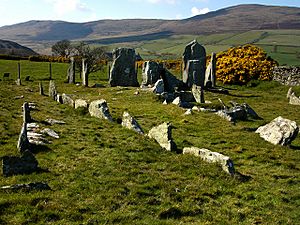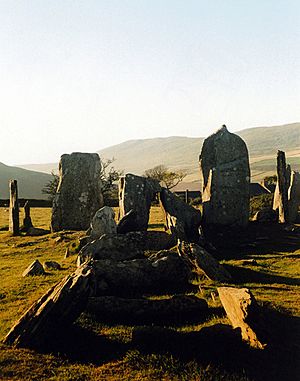Cashtal yn Ard facts for kids

View of Cashtal yn Ard burial chamber.
|
|
| Location | Cornaa, Maughold, Isle of Man |
|---|---|
| Region | Isle of Man |
| Coordinates | 54°16′41″N 4°21′33″W / 54.27803°N 4.35912°W |
| History | |
| Periods | Neolithic |
Cashtal yn Ard is an ancient burial place on the Isle of Man. Its name means Castle of the Heights in the Manx language. This special site is a Neolithic chambered tomb. It is found in Cornaa, in the area called Maughold.
This tomb sits on a low hill. From here, you can see much of the surrounding land. You can even see across to the Lake District in England. Archaeologists dug here in the 1930s and again in 1999. Cashtal yn Ard is one of the most important ancient stone tombs in both the Isle of Man and Britain.
What Does the Name Mean?
The name Cashtal yn Ard comes from the Manx language. It means Castle of the Heights. This name describes how the tomb is built on a high spot.
Long ago, people also called this place Cashtal y Mucklagh y Vagileragh. This means Castle of the Field Pigsty. Some think this name came about because the front area of the tomb was once used to keep pigs!
Another old name for the tomb was Ballachrink Cairn.
What Does the Tomb Look Like?
This tomb was built around 2000 BC. It is one of the best-preserved ancient monuments on the Isle of Man. The site is very long, about 39 meters (128 feet) from west to east.
The tomb is on a small hill with great views. This might have been important to the people who built it. They may have wanted to show a difference between daily life in the lowlands and special ceremonies on the hills. It is thought that the tomb started as one burial chamber. Over time, as important people died, it was made bigger to hold more burials.
The tomb has an open area at the front, facing west. This area is called a forecourt. It leads to five stone rooms inside the tomb, which face east. The forecourt is about 6.7 meters (22 feet) long and 5.8 meters (19 feet) wide. It has been repaired. Some of its large stones are as tall as 2.3 meters (7.5 feet).
The five stone rooms are separated by tall stone slabs. The stones forming these rooms are about 1 meter (3.3 feet) high. They get smaller as you go towards the east end. Each room is about 1.2 meters (4 feet) wide.
People first wrote about this tomb in the early 1800s. Back then, most of it was still in good shape. By the mid-1800s, parts of the tomb were damaged. Some of the stone slabs were taken to build nearby houses. This is why the five smaller rooms are now open and easy to see.
What Did Archaeologists Find?
Archaeologists H. J. Fleure and G. J. H. Neely dug at the site in the 1930s. They found small stone tools called flints. They also found pieces of ancient pottery from the Neolithic period.
During their digs, they discovered at least 125 white sea pebbles. These special pebbles have been found at many other ancient sites on the Isle of Man. No human bones were found during this dig.
However, an earlier explorer named Llewellynn Jewitt wrote about the site in 1885. He reported finding bone pieces from a young person. He also found pieces of two different ancient pots. One pot was black and made of crushed granite. The other was red and made of a more earthy material. It is possible that other human remains were removed from the tomb a long time ago.
Fleure and Neely noticed that Cashtal yn Ard looks similar to other ancient tombs. These include the Giants' Tombs in Sardinia and the Bridestones in Cheshire, England.



